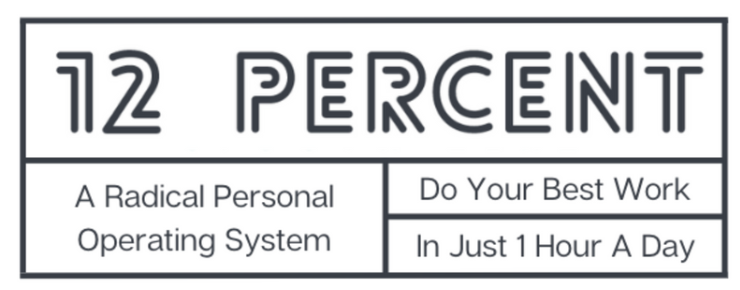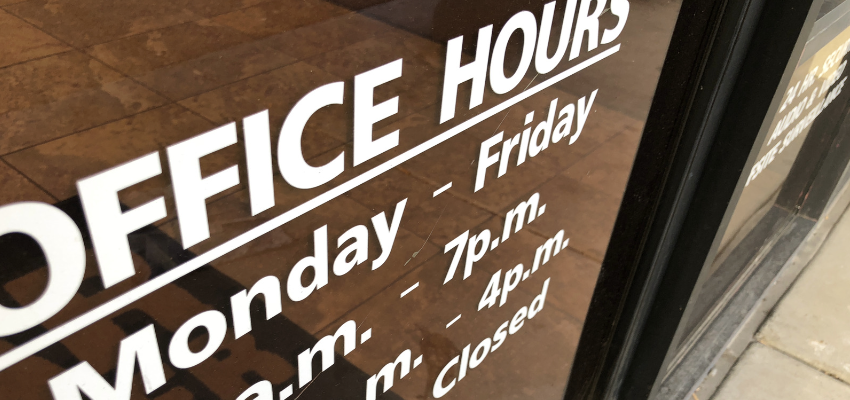Five Strategies to Tame Your Beast of a Workday

Themes: Bias to Action, Hacks
Any job, given enough time, can turn into something that you don't like. This feeling of discontentment might not result from the job itself or the people you work with. Instead, it's an unspecified malaise that takes hold of your experience.
You don't have to be the unwitting protagonist. You can take control and use action and targeted strategies to improve your output and your overall experience.
But it won't be easy.
The system of a paycheck job is designed to wear you down into compliance by forcing you to adopt the "success culture" as Venkatesh Rao describes in this book review:
— people who are paid more are more worthy
— jobs are in a hierarchy of prestige, and that’s good — prestige is a good variable to maximize
— spreadsheet-optimizing job-hunting is healthy
You're stuck playing a game that the vast majority can't technically win. You have to be a part of it daily. You want to be good at it, but it's unclear how.
Until you find the way out, you are stuck inside the script.
This Is Not a Bad Dream
The best analogy I have is an M. Night Shyamalan movie.
What makes these movies unique is that everyone is affected by this terrible force that no one can see, explain or understand. It's a combination of dread and unsettling emotions that slowly build up over time, making it harder and harder to enjoy what was once a dream job. Even the protagonist doesn't discover what's happening until the end.
The truth is that there is no such creature.
The Truth is Worse than You Imagined
You are still locked in a fierce battle, but it's not with one monster. It's a series of endless tiny monsters.
- There are the OPAs (Other People's Agendas) that want to give you work to do.
- There's the IS (Idea Sharer) a creature who turns normal meetings into spontaneous brainstorming sessions for no reason.
- How about the Deflectooor? This one possesses teammates and tricks them into sending one-question responses, forever prolonging a simple task.
The list goes on while that stuff you wanted to do is still sitting in the same place on your desk.
Act to Retake Control of Your Work Day
Every good movie has that unique moment when the protagonist realizes what's happening and decides to act.
The bad news is that you have work to do. Only you can turn your story around.
The good news? You don't have to be like the typical action hero, and spend months in an abandoned warehouse in Siberia training for some intense physical combat to redeem your identity. I've done that for you.
Maybe I haven't, but I have found a few basic steps to help you regain control of your day.
There is no one way to use the following steps, instead, start with the one that seems to have the least impossibility associated with it.
Remember, it's not about the outcomes. This is about taking action. Over time you'll develop confidence and be able to build on your progress.

Retake the First Hour
Something happens to people when they start working. Even if you don't go "to the office" anymore, you aren't immune. We have rituals and habits that we follow to get started.
I first wrote about this strategy in The One Step That Unlocks Your Work Day.
The first hour is crucial in setting the tone for the rest of your day. Using this time effectively is important, enabling you to take control and act on your priorities.
Action: Allocate the first hour of your day to tackle tasks that have been weighing on your mind.
Start by setting aside time for this hour, either at the beginning of your workday or just before it begins. During this time, jot down the pressing tasks that come to mind, avoiding distractions from technology and to-do lists.
Objective: To unload your mental clutter, create a concise list, and prioritize using a planning template.
Divide this hour into four segments: 30 minutes, 15 minutes, and two 7.5-minute blocks. Place your four tasks within the template, set a timer, and start working. By the end of the hour, you'll have completed four important tasks.
Regardless of how the rest of your day unfolds, you'll feel a sense of accomplishment, knowing you've made progress on significant tasks. While it may seem trivial, a focused hour can enhance your performance by in incredible 12 percent.
Don't get caught up in overambitious strategies that promise to 10x your output.
Focus on the value derived from consistent action. A 12 percent improvement over time can lead to remarkable results. Harnessing the power of your first hour sets the stage for a productive day and helps you achieve more than you ever imagined.

Office Hours vs Meetings
Ping. Ding. Beep-boop. Swoooooosh.
It's easy to get caught up in the never-ending stream of notifications, emails, and messages. We often spend more time responding to these distractions than actually getting our work done. That's why I turned to author Cal Newport and his concept of "deep work."
Deep work is the idea that by structuring our day to focus on one task at a time, we can accomplish even the most difficult tasks with ease. By eliminating distractions and allowing ourselves to fully immerse in our work, we can achieve a flow state leading to increased productivity and creativity.
But how do we achieve this state of deep work in a world that demands constant communication and immediate responses?
That's where the concept of "office hours" comes in.
I first discovered the office hours strategy proposed by Cal during my research on improving work productivity. As someone who has worked at several start-ups where Slack was the default communication method, I found myself constantly toggling notifications and trying to keep up with the fast-paced demands of my team.
"Each individual posts a schedule of two or three stretches of time during the day when he or she will be available for communication. During these office hours, the individual guarantees to be reachable in person, by phone, and by instant messenger technologies like Slack. Outside of someone’s stated office hours, however, you cannot command their attention. If you need them, you have to keep track of what you need until they’re next available." Cal Newport in Fast Company
But after implementing the office hours strategy, I found that I could take control of my day and eliminate the stress associated with constant communication.
The strategy is deceptively simple - block off one or two times a day where you are available for communication, and make sure everyone knows when those times are.
In my case, I used 11 AM and 2 PM as default hour-long blocks where I was available. I set all of my meeting availability to be in those windows, but I wouldn't send out meeting invitations. Instead, when somebody reached out to me, I would refer them to the next available office hour.
At first, it was a minor inconvenience for the person with the question, but after a few weeks, people started figuring out that I had free time that they didn't need to ask me right away.
This was transformative for me in terms of productivity. I no longer had to check for notifications or emails on a regular basis throughout my day. I could wait until office hours when I could tackle all of those open challenges by dividing my attention between the work I needed to do and the work required for supporting the team.
The office hours strategy helped me to increase productivity and decrease my stress. And the best part? This strategy can be applied to any work or industry. Whether you're an academic, an author, or a startup leader like I was, the office hours strategy can help you regain control of your day and remain firmly in control of your goals and outcomes.

Deadlines vs. To Dos
As we progress in our careers and take on more responsibilities, it's natural to seek out ways to stay organized and on top of what our teams and we are responsible for.
Most people would create a to-do list and diligently check off items individually. However, this approach is 100% not effective for managers and leaders.
Never write to-dos in stone. You will be 10x more productive if you reprioritize daily. Codie Sanchez @Codie_Sanchez
Instead of relying on a to-do list, manage deadlines.
When working on a project, there are countless components to consider and numerous stakeholders involved. Rather than getting bogged down in the details, effective leaders should focus on keeping track of deliverable deadlines and the people responsible for them.
No one else cares about your to do items, there is no score.
This deadline-only mentality allows for a clear understanding of what needs to be done and when without getting caught up in the minutia of each task. By zooming out just enough to see the big picture, leaders can empower their teams to take ownership of their work and trust them to keep track of the details.
There are countless ways to manage deadlines effectively, from using a calendar to project management software. The key is to find an approach that works for your specific work environment and stick with it.
Effective leadership creates a culture of accountability and trust among team members. By focusing on deadlines vs. tasks, we can maintain the flexibility required to stay on track without becoming a roadblock.

The One Day Rule
I value productivity and efficiency, and my personal strategy, the One Day Rule helps me stay on track regardless of what else is happening.
The rule is simple: I don't tackle new tasks until tomorrow at the earliest.
Action: When I get a new task, project or assignment, I tell the person I'll have something for them tomorrow.
This respects my current work process and helps avoid prioritzing the new over the important.
The One Day Rule has psychological and strategic benefits, allowing my subconscious time to process information. Waiting until the next day lets me finish ongoing tasks and approach new ones with a fresh perspective.
But it's not just psychological. Speed to completion isn't usually helpful with new tasks. By creating space, I can see the bigger picture and act accordingly. I prioritize the task for the next day, supporting my team without disrupting my flow.
Over time, people will begin to trust your process. They see you taking down the information and then delivering valuable insight the next day.
Outome: By following this process, you can change the working culture of your small group or even your department.
Moving towards a more asynchronous approach gives room for people to be their personal best. Outside of Hollywood, there is no positive correlation between high-speed work and optimal outcomes.

The Power Nap
Taking a power nap is a game-changer for productivity.
Many people fail to recognize the negative trend of their productivity throughout the day, with small outlying events masking an overall decline from high to low.
Studies consistently show that people define "work" as only 50% of their total time on the job.
A strategic rest can help increase bandwidth and improve the quality of work.
Rather than taking short breaks to walk to the kitchen or to step outside, a power nap offers a completely different approach.
Finding a quiet place to close your eyes, focus on deep breathing, and bring your body into a state of rest can profoundly impact productivity, memory retention, and mood for the rest of the day.
1. Naps can improve mood and increase energy. According to various studies, daytime naps can aid recovery during sickness, remedy sleep deprivation, and improve mood. Napping can also reduce daytime sleepiness and increase energy levels.
2. Napping helps with memory consolidation. For infants, napping is a crucial part of memory consolidation, especially after learning a new skill or synthesizing an experience.
Matthew Walker [https://www.masterclass.com/articles/matthew-walkers-defense-of-napping#6Ew8jEJUBfa2a97vYJ7YYP]
A power nap can feel like a second start to the workday. It can help avoid relying on sugar or caffeine and reset the mind for otherwise arduous afternoon sessions, turning them into opportunities for creativity and growth.
In the long term, power napping can also offset any disruptions to sleep outside of work, complementing other aspects of a healthy lifestyle like exercise and hobbies that require early mornings.
Even working from home, it's important to find a quiet and comfortable space to power nap. With a baseball hat and noise-canceling earbuds, creating the perfect conditions for a quick, restful nap is possible. Spending 15 minutes breathing deeply and clearing the mind can make all the difference without sacrificing too much time or productivity.
Overall, taking a power nap during the day is a strategic advantage that can help anyone improve their work performance, mood, and overall well-being.

This... Is Just the Beginning
Improving your work experience can seem daunting, but it is not impossible. There is no one-size-fits-all solution to instantly make your work experience better.
Remember, you understand best what will work for you, even if you cannot see it now.
Pick any one of the methods ^above^ and put it into action. It is essential to start small and build up from there. You will see the progress and impact that even small changes can have on your perceived effort and actual deliverables.
As you build confidence in the process of regaining agency, you will notice significantly better trends across the entire workday.
The goal isn't to work at peak performance for the entire day.
The aim is to make sure that the work you do is meaningful and effective.
Your best work.
Being effective and engaged when you are in work mode, whether that is in the office or at home, creates space for you to be your best self at home or at play.
But that's a topic for another day. For now, good skill.
Keep me posted in the comments and on Twitter @pmccrann.
